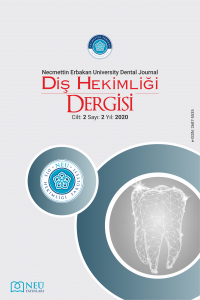Yüksek Çürük Riskli Genç Yetişkinlerde Çürük Değerlendirme Spektrumu ve Tedavisi (CAST) indeksi Kullanımının Etkinliği: Klinik Çalışma
Abstract
Amaç: Bu çalışmanın amacı 20 yaşındaki genç yetişkinlerin büyük azı dişlerinde güncel Çürük Değerlendirme Spektrumu ve Tedavisi (CAST) indeksi kullanımının etkinliğini incelemekti.
Yöntemler: Çalışma yüksek çürük riski belirtileri gösteren 20 yaşındaki 50 genç erişkinde gerçekleştirildi. Çürük riski yüksek olan bireyleri tanımlamak için Significant Caries Index kullanıldı. Hastalar çalışma hakkında bilgilendirildi ve aydınlatılmış onam formu alındı. Hastaların klinik ve radyografik incelemeleri yapıldı. Tek bir araştırmacı tarafından CAST kategorilerinin yaygınlığı birinci ve ikinci büyük azı dişleri açısından değerlendirildi. Değerlendirilen dişler arasında CAST kodlarının dağılımının korelasyonunu araştırmak için Spearman sıra korelasyon katsayısı kullanıldı. İnceleyici içi güvenilirlik, kappa katsayısı ile belirlendi. İstatistiksel anlamlılık düzeyi p <0,05 olarak belirlendi.
Bulgular: Büyük azı dişleri ile ilgili olarak birinci azı dişleri %85 oranında etkilenmiş iken, ikinci büyük azı dişlerde %73 çürük veya restorasyon gözlendi ve çoğu lezyon kavitasyon dışı düzeyde skorlandı. Alt birinci ve ikinci büyük azılar üstlere göre fazla etkilenmiş bulundu. Pulpa kaybı, sepsis ve çürük nedeniyle kayıp birinci azı dişlerinde daha yaygın olduğu bulundu. Ağız boşluğunun sağ ve sol tarafında dişlerin durumu arasında güçlü bir korelasyon bulundu. Birinci ve ikinci büyük azı dişlerin durumunun korelasyonu, sağda ağzın sol tarafına göre daha güçlü, r maksillada 0.639 ve 0.487 ve mandibulada 0.592 ve 0.365 idi (p <0.001). Gözlemci içi güvenilirlik kalıcı azı dişleri için 0.90 olarak belirlendi.
Sonuçlar: Bu çalışma da güncel CAST indeksi sonuçlarına göre çürük riski yüksek olan genç yetişkinlerin azı dişleri çürükten ciddi derecede etkilenmiş bulundu. Çalışma sonuçlarına göre epidemiyolojik araştırmalarda CAST indeksinin yararlı olabileceği düşünülmektedir.
Keywords
References
- 1. Bagramian RA, Garcia-Godoy F, Volpe AR. The global increase in dental caries. A pending public health crisis. Am J Dent. 2009;22:3–8.
- 2. World Health Organization. Oral health surveys basic methods. 4. Geneva: World Health Organization; 1997.
- 3. Pitts NB, Ekstrand KR. Intrnational Caries Detection and Assessment System (ICDAS) and its International Caries Classification and Management System (ICCMS) – methods for staging of the caries process and enabling dentist to manage caries. Community Dent Oral Epidemiol. 2013;41:e41–e52. doi: 10.1111/cdoe.12025.
- 4. Monse B, Heinrich-Weltzien R, Benzian H, Holmgren C, van Palenstein Helderman W. PUFA—an index of clinical consequences of untreated dental caries. Commun Dent Oral Epidemiol. 2010;38:77–82. doi: 10.1111/j.1600-0528.2009.00514
- 5. Baginska J, Stokowska W. Pulpal Involvement-Roots-Sepsis (PRS) Index: a new method for describing the clinical consequences of untreated dental caries. Med Princ Pract. 2013;22:555–560. doi: 10.1159/000354193.
- 6. Frencken JE, de Amorim RG, Faber J, Leal S. The Caries Assessment Spectrum and Treatment (CAST) index: rational and development. Int Dent J. 2011;61:117–123. doi: 10.1111/j.1875-595X.2011.00022.x.
- 7. Frencken JE, de Souza AL, van der Sanden WJM, Bronkhorst EM, Leal SC. The Caries Assessment Spectrum and Treatment (CAST) instrument. Community Dent Oral Epidemiol. 2013;61:117–123.
- 8. de Souza AL, van der Sanden WJM, Leal S, Frencken JO. The Caries Assessment Spectrum and Treatment (CAST) index: face and content validation. Int Dent J. 2012;62:270–276. doi: 10.1111/j.1875-595X.2012.00121.x.
- 9. De Souza AL, Leal SC, Chaves SB, Bronkhorst EM, Frencken JE, Creugers NHJ. The Caries Assessment Spectrum and Treatment (CAST) instrument: construct validation. Eur J Oral Sci. 2014. doi: 10.1111/eos.12116
- 10. De Souza AL, Bronkhorst EM, Creugers NHJ, Leal SC, Frencken JE. The Caries Assessment Spectrum and Treatment (CAST) instrument: its reproducibility in clinical studies. Int Dent J. 2014. doi: 10.1111/idj.12104
- 11. Sheiham A, Sabbah W. Using universal patterns of caries for planning and evaluating dental care. Caries Res. 2010;44:141–150. doi: 10.1159/000308091.
- 12. Hujoel PP, Lamont RJ, DeRouen TA, Davis S, Leroux BG. Within-subject coronal caries distribution patterns: an evaluation of randomness with respect to the midline. J Dent Research. 1994;73:1575–1580.
- 13. Mejàre I, Stenlund H. Caries rates for the mesial surface of the first permanent molar and the distal surface of the second primary molar from 6 to 12 years of age in Sweden. Caries Res. 2000;34:454–461. doi: 10.1159/000016623.
- 14. Batchelor P, Sheiham A. Grouping of tooth surfaces by susceptibility to caries: a study in 5–16 year-old children. BMC Oral Health. 2004;4:2. doi: 10.1186/1472-6831-4-2.
- 15. Burnside G, Pine CM, Williamson PR. Modelling the bilateral symmetry of caries incidence. Caries Res. 2008;42:291–296. doi: 10.1159/000148161.
- 16. Vanonbbergen J, Lesaffre E, Garcia-Zattera MJ, Jara A, Martens L, Declerck D. Caries patterns in primary dentition in 3-, 5- and 7-year-old children: spatial correlation and preventive consequences. Caries Res. 2007;41:16–25. doi: 10.1159/000096101.
- 17. Alm A, Wendt LK, Koch G, Birkhed D. Prevalence of approximal caries in posterior teeth in 15-year-old Swedish teenagers in relation to their caries experience at 3 years of age. Caries Res 2007;41:392–398.
- 18. Isaksson H, Alm A, Koch G, Birkhed D, Wendt LK. Caries Prevalence in Swedish 20-Year-Olds in Relation to Their Previous Caries Experience. Caries Res 2013;47:234-42.
- 19. Duman, S., & Duruk, G. (2018). 6-12 Yaş Grubu Çocuklarda Daimi Birinci Büyük Azı Dişlerin Önemi ve Değerlendirilmesi – Derleme. Atatürk Üniversitesi Diş Hekimliği Fakültesi Dergisi Vol. 4, Issue 28, pp. 610–624.
- 20. Chestnutt, I. G., Schafer, F., Jacobson, A. P. M., & Stephen, K. W. (1996). Incremental susceptibility of individual tooth surfaces to dental caries in Scottish adolescents. In Community Dentistry and Oral Epidemiology (Vol. 24, Issue 1, pp. 11–16).
- 21. Vehkalahti, M. M., Solavaara, L., & Rytömaa, I. (1991). An Eight-year Follow-up of the Occlusal Surfaces of First Permanent Molars. In Journal of Dental Research (Vol. 70, Issue 7, pp. 1064–1067).
- 22. Ünlü, N., Şener, S., Karabekiroğlu, S. (2014). Genç yetişkinlerde birinci büyük azı dişinde çürük görülme sıklığı ve ağız bakım faktörleri ile ilişkisi. In Selcuk Dental Journal (Vol. 1, Issue 1, pp. 14–14).
Details
| Primary Language | Turkish |
|---|---|
| Subjects | Dentistry |
| Journal Section | RESEARCH ARTICLE |
| Authors | |
| Publication Date | October 31, 2020 |
| Submission Date | July 13, 2020 |
| Acceptance Date | September 17, 2020 |
| Published in Issue | Year 2020 Volume: 2 Issue: 2 |

